
Castor is the second-brightest object in the zodiac constellation of Gemini. It has the Bayer designation α Geminorum, which is Latinised to Alpha Geminorum and abbreviated Alpha Gem or α Gem. With an apparent visual magnitude of 1.58, it is one of the brightest stars in the night sky. Castor appears singular to the naked eye, but it is actually a sextuple star system organized into three binary pairs. Although it is the 'α' (alpha) member of the constellation, it is fainter than 'β' (beta) Geminorum, Pollux.

GK Persei was a bright nova first observed on Earth in 1901. It was discovered by Thomas David Anderson, an Edinburgh clergyman, at 02:40 UT on 22 February 1901 when it was at magnitude 2.7. It reached a maximum magnitude of 0.2, the brightest nova of modern times until Nova Aquilae 1918. After fading into obscurity at about magnitude 12 to 13 during the early 20th century, GK Persei began displaying infrequent outbursts of 2 to 3 magnitudes. Since about 1980, these outbursts have become quite regular, typically lasting about two months and occurring about every three years. Thus, GK Persei seems to have changed from a classical nova like Nova Aquilae 1918 to something resembling a typical dwarf nova-type cataclysmic variable star.

DQ Herculis, or Nova Herculis 1934, was a slow, bright nova occurring in the northern constellation of Hercules in December 1934. This cataclysmic variable star was discovered on 13 December 1934 by J. P. M. Prentice from Stowmarket, Suffolk. It reached peak brightness on 22 December 1934 with an apparent magnitude of 1.5. The nova remained visible to the naked eye for several months.
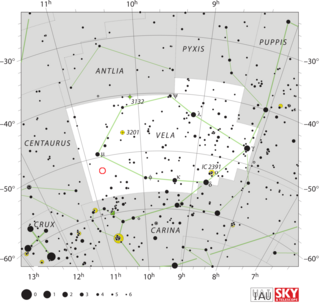
V382 Velorum, also known as Nova Velorum 1999, was a bright nova which occurred in 1999 in the southern constellation Vela. V382 Velorum reached a brightness of 2.6 magnitude, making it easily visible to the naked eye. It was discovered by Peter Williams of Heathcote, New South Wales, Australia at 09:30 UT on 22 May 1999. Later that same day it was discovered independently at 10:49 UT by Alan C. Gilmore at Mount John University Observatory in New Zealand.
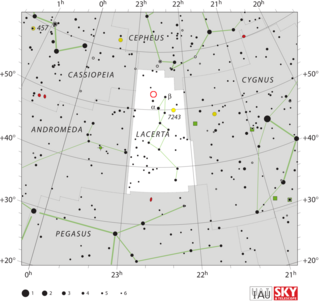
DI Lacertae or Nova Lacertae 1910 was a nova in constellation Lacerta which appeared in 1910. It was discovered by Thomas Henry Espinell Compton Espin at Wolsingham Observatory on 30 Dec 1910, at which time it was an 8th magnitude object. Subsequent examination of pre-discovery photographic plates showed that the outburst occurred sometime between 17 November 1910 and 23 November 1910. It reached a peak brightness of magnitude 4.6 on 26 November 1910, making it visible to the naked eye. Before the nova event DI Lacertae was a 14th magnitude star, and by 1950 it had returned to 14th magnitude.

CP Lacertae was a nova, which lit up on June 18, 1936 in the constellation Lacerta. It was discovered independently by several observers including Leslie Peltier in the US, E. Loreta in Italy, and Kazuaki Gomi, a Japanese barber who discovered the nova during the 19 June 1936 total solar eclipse.

BT Monocerotis was a nova, which lit up in the constellation Monoceros in 1939. It was discovered on a spectral plate by Fred L. Whipple on December 23, 1939. BT Monocerotis is believed to have reached mag 4.5, which would have made it visible to the naked eye, but that value is an extrapolation; the nova was not observed at peak brightness Its brightness decreased after the outbreak by 3 magnitudes in 182 days, making it a "slow nova". The light curve for the eruption had a long plateau period.

HR Lyrae or Nova Lyrae 1919 was a nova which occurred in the constellation Lyra in 1919. Its discovery was announced by Johanna C. Mackie on 6 December 1919. She discovered it while examining photographic plates taken at the Harvard College Observatory. The bulletin announcing the discovery states "Between December 4 and 6 it rose rapidly from the sixteenth magnitude or fainter, to a maximum of about 6.5". It was the first nova ever reported in Lyra, and Mackie was awarded the AAVSO gold medal for her discovery. Its peak magnitude of 6.5 implies that it might have been visible to the naked eye, under ideal conditions.

DK Lacertae was a nova, which lit up in the constellation Lacerta in 1950. The nova was discovered by Charles Bertaud of the Paris Observatory on a photographic plate taken on 23 January 1950. At the time of its discovery, it had an apparent magnitude of 6.1. DK Lacertae reached peak magnitude 5.0, making it easily visible to the naked eye.
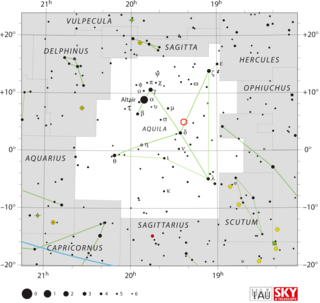
V1494 Aquilae or Nova Aquilae 1999 b was a nova which occurred during 1999 in the constellation Aquila and reached a brightness of magnitude 3.9 on 2 December 1999. making it easily visible to the naked eye. The nova was discovered with 14×100 binoculars by Alfredo Pereira of Cabo da Roca, Portugal at 18:50 UT on 1 December 1999, when it had a visual magnitude of 6.0.

V842 Centauri, also known as Nova Centauri 1986, was a nova which occurred in 1986 in the constellation Centaurus. It was discovered by Robert H. McNaught of Siding Spring Observatory in Australia, on 22 November 1986. At the time of its discovery, it had an apparent magnitude of 5.6. It reached a peak magnitude of 4.6 one and a half days later, making it easily visible to the naked eye.
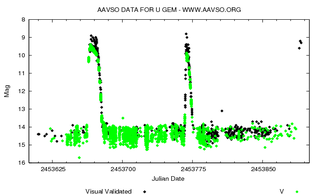
U Geminorum, in the constellation Gemini, is an archetypal example of a dwarf nova. The binary star system consists of a white dwarf closely orbiting a red dwarf. Every few months it undergoes an outburst that greatly increases its brightness. The dwarf nova class of variable stars are often referred to as U Geminorum variables after this star.

RX Andromedae is a variable star in the constellation of Andromeda. Although it is classified as a dwarf nova of the Z Camelopardalis (UGZ) type, it has shown low-luminosity periods typical of VY Sculptoris stars. However, for most of the time it varies from an apparent visual magnitude of 15.1 at minimum brightness to a magnitude of 10.2 at maximum brightness, with a period of approximately 13 days.

V339 Delphini or Nova Delphini 2013 (PNV J20233073+2046041) is a bright nova star in the constellation Delphinus. It was discovered on 14 August 2013 by amateur astronomer Koichi Itagaki in Japan and confirmed by the Liverpool Telescope on La Palma. The nova appeared with a magnitude 6.8 when it was discovered and peaked at magnitude 4.3 on 16 August 2013. A nova is produced by the fusion of accumulated material on the white dwarf nova progenitor acquired from its companion star. The nova system is thus a binary star, and a classical nova. The white dwarf is a carbon-oxygen white dwarf, with an estimated mass of 1.04±0.02 M☉. There is not yet a consensus about what the binary's orbital period is; estimates range from 3.15 hours to 6.43 hours.
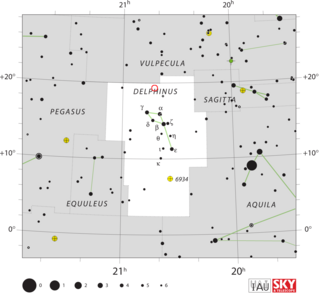
HR Delphini, also known as Nova Delphini 1967, was a nova which appeared in the constellation Delphinus in 1967. It was discovered by George Alcock at 22:35 UT on 8 July 1967, after searching the sky for over 800 hours with binoculars. At the time of discovery it had an apparent magnitude of 5.0. It reached a peak brightness of magnitude 3.5 on 13 December 1967, making it easily visible to the naked eye around that time. Pre-outburst photographs taken with the Samuel Oschin telescope showed it as a ~12th magnitude star which might have been variable.

SU Ursae Majoris, or SU UMa, is a close binary star in the northern circumpolar constellation of Ursa Major. It is a periodic cataclysmic variable that varies in magnitude from a peak of 10.8 down to a base of 14.96. The distance to this system, as determined from its annual parallax shift of 4.53 mas, is 719 light-years. It is moving further from the Earth with a heliocentric radial velocity of +27 km/s.

V455 Andromedae is a dwarf nova in the constellation Andromeda. It has a typical apparent visual magnitude of 16.5, but reached a magnitude of 8.5 during the only observed outburst.

QZ Aurigae, also known as Nova Aurigae 1964, was a nova which occurred in the constellation Auriga during 1964. It was discovered by Nicholas Sanduleak on an objective prism photographic plate taken at the Warner and Swasey Observatory on 4 November 1964. Examination of pre-discovery plates from Sonneberg Observatory showed that the eruption occurred in early February 1964, and it had a photographic magnitude of 6.0 on 14 February 1964. Its brightness declined in images taken after the 14th, suggesting that its peak brightness was above 6.0. It was probably visible to the naked eye for a short time.
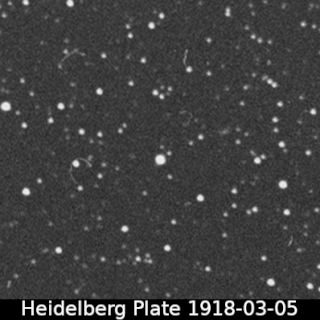
GI Monocerotis, also known as Nova Monocerotis 1918, was a nova that erupted in the constellation Monoceros during 1918. It was discovered by Max Wolf on a photographic plate taken at the Heidelberg Observatory on 4 February 1918. At the time of its discovery, it had a photographic magnitude of 8.5, and had already passed its peak brightness. A search of plates taken at the Harvard College Observatory showed that it had a photographic magnitude of 5.4 on 1 January 1918, so it would have been visible to the naked eye around that time. By March 1918 it had dropped to ninth or tenth magnitude. By November 1920 it was a little fainter than 15th magnitude.

SW Ursae Majoris is a cataclysmic binary star system in the northern circumpolar constellation of Ursa Major, abbreviated SW UMa. During quiescence it has an apparent visual magnitude of 16.5–17, which is too faint to be visible to the naked eye. Based on parallax measurements, it is located at a distance of approximately 526 light years from the Sun.





















